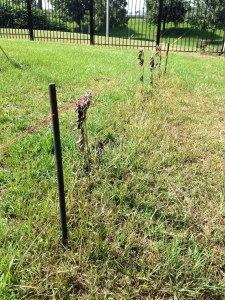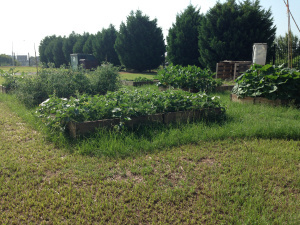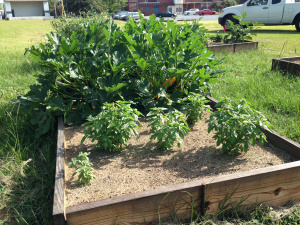Foster Dickson's Blog, page 91
August 16, 2015
A writer-editor-teacher’s quote of the week #80
The goal of the ESY curriculum is to empower students with the knowledge and values to make food choices that are healthy for them, their communities, and the environment.
The curriculum becomes more relevant, engaging, and further supports their classroom achievement by bringing academic subjects to life. In addition to intentional academic connections, the curriculum also develops in students: a sense of curiosity and dignity; the ability to work as a team to complete a job well; respect for oneself and others; an appreciation for diversity; and an understanding of how the ritual of eating together at the table connects families and communities.
– from the About page for The Edible Schoolyard Berkeley
Filed under: Teaching, Writing and Editing



August 11, 2015
The Green Pope— Francis, that is.
Earlier this year, my post “Shut Up, Doomsayers!” focused on my desire to hear a solution-oriented discussion of our global environmental problems. I’m tired of hearing how the planet is falling apart, largely due to human behavior, without hearing much about how to change it. That post was published back in February.
All I really needed was to wait until May, when Pope Francis published his encyclical, Laudato Si. This 245-point treatise, separated into six chapters, may focus on ecological concerns, but it also weaves these issues into greater matters of faith, values, materialism, greed, and social justice. Early on, Pope Francis had me hooked; in point 14, under the heading “My Appeal,” he writes,
I urgently appeal, then, for a new dialogue about how we are shaping the future of our planet. We need a conversation which includes everyone, since the environmental challenge we are undergoing, and its human roots, concern and affect us all. The worldwide ecological movement has already made considerable progress and led to the establishment of numerous organizations committed to raising awareness of these challenges. Regrettably, many efforts to seek concrete solutions to the environmental crisis have proved ineffective, not only because of powerful opposition but also because of a more general lack of interest. Obstructionist attitudes, even on the part of believers, can range from denial of the problem to indifference, nonchalant resignation or blind confidence in technical solutions. We require a new and universal solidarity. As the bishops of Southern Africa have stated: “Everyone’s talents and involvement are needed to redress the damage caused by human abuse of God’s creation”. All of us can cooperate as instruments of God for the care of creation, each according to his or her own culture, experience, involvements and talents.
Everyone may not own property on this planet, but everyone does live on it and rely on it. We all need the air, water and food that the Earth provides. That “universal solidarity” makes us all stakeholders in finding solutions to environmental problems.
After his introduction, the pope’s six chapters interweave social concerns, scientific findings and Catholic teachings, and we end with a closing prayer. The first three chapters identify the problem and the role of faith in solving it. This crisis isn’t only a matter of public policy or geopolitics. The head of the world’s largest religious denomination is weighing in, and he has his say in Laudato Si.
Moving along, in chapter Four, “Integral Ecology,” Pope Francis insists that, as a part of the system, we have all to participate responsibly in this discourse. He writes, in point 161:
Doomsday predictions can no longer be met with irony or disdain. We may well be leaving to coming generations debris, desolation and filth. The pace of consumption, waste and environmental change has so stretched the planet’s capacity that our contemporary lifestyle, unsustainable as it is, can only precipitate catastrophes, such as those which even now periodically occur in different areas of the world. The effects of the present imbalance can only be reduced by our decisive action, here and now.
I have children, who were born in the first decade of the millenium, and I’d like to think that their lifespan will run into the 2070s and 2080s. And, if they have children of their own, my grandchildren’s lives could extend into the twenty-second century. This downward environmental destruction may be slow, but I want to know that we did all we could, for everyone we could help, in the 2000s, 2010s and 2020s. Catholics love to talk about the respect for the unborn— well, this looming environmental is all about the unborn.
Chapter five, “Lines of Approach and Action,” focuses on what we need to be doing now. Here Pope Francis gets down on ground level, offering a series of point-by-point discussions of individuals efforts, how they succeeded or failed, and also reminding us in point 180:
There are no uniform recipes, because each country or region has its own problems and limitations. It is also true that political realism may call for transitional measures and technologies, so long as these are accompanied by the gradual framing and acceptance of binding commitments. At the same time, on the national and local levels, much still needs to be done, such as promoting ways of conserving energy.
Pope Francis is right. We can’t just wake up one morning and decide to be “green.” If we’re going to phase out fossil fuels, we can’t just outlaw gasoline and oil one day! Public policy has to be shaped, which will lead us through changing over our cars, allowing time to comply with new standards. Oil and gas workers need to be re-trained for new jobs, and refineries need to be shut down responsibly. The switch-over would take years.
Laudato Si takes time to read and to absorb, and the pope’s immense understanding of our faith connects so many features of our lives to this issue. For example, he writes at one point that we should not respect the irresponsible “trafficking” of goods . . . nor of human beings. One running theme of this encyclical is interconnectedness: we are all children of God, taking our sustenance from God’s creation, and as such we should be respectful of God and each other.
So where do we go from here? In point 194, he writes:
For new models of progress to arise, there is a need to change “models of global development” this will entail a responsible reflection on “the meaning of the economy and its goals with an eye to correcting its malfunctions and misapplications.” It is not enough to balance, in the medium term, the protection of nature with financial gain, or the preservation of the environment with progress. Halfway measures simply delay the inevitable disaster. Put simply, it is a matter of redefining our notion of progress.
In the final chapter, Pope Francis offers an alternative, because “we human beings above all who need to change.” This better way is a life that ties in ecological awareness as an essential component of one’s faith. Our Catholic faith reminds us that all people are sinners, that all people can do better.
NOTE: For further reading, The Atlantic published a short piece titled “The Father, The Sun, and the Holy Spirit,” in its April 2011 issue, about then-Pope Benedict’s efforts to green up the Vatican.
Filed under: Catholicism, Civil Rights, Social Justice, The Environment



August 9, 2015
A writer-editor-teacher’s quote of the week #79
I suspect that in most people’s minds—and perhaps in my own—the activism justifies the withdrawal. To see hermit and activist as different parts of the same person’s life should be easy. But to see the hermit as an activist, or withdrawal as activity, requires a leap of mind and faith that is altogether radical. There must be a place for the life of the total recluse, the hermit who gets nothing done. We need to work our way toward understanding that contemplatives, although we don’t see them and they don’t do anything, can be defenders of the society in which they don’t live, guardians and protectors of the public good.
– from “The Hermit as Activist: In Search of Subversive Selflessness” by David Budbill, appearing on the Utne Reader online, originally published in Shambhala Sun in July-August 1999.
Filed under: Teaching, Writing and Editing



August 4, 2015
August’s Southern Movie of the Month
If you’ve never heard of the old black-and-white movie “Way Down South,” I can tell you one reason why: it’s about the fall of a pre-Civil War slave-holding family in the Deep South— and it came out in 1939, the same year as “Gone with the Wind.” Yet, as we think about cinematic epics, this one-hour-and-fifteen-minute movie isn’t in the same category as that famous adaptation of Margaret Mitchell’s 1940 novel. Part of me wants to call “Way Down South” a musical comedy, but that seems in really poor taste, given our modern understanding of slavery. Though it does contain musical numbers and it does end well (by 1930s standards), the film starts us off with yet another of those fictitious portrayals where the kindly master is much loved his happy slaves.
We begin at the great plantation Bayou Lovelle in southern Louisiana, where the slaves are just finishing up with harvesting the sugar cane. After a meeting with his sour and business-like lawyer Martin Dill, the felicitous master and his beaming son Timothy load up in the wagon, driven by the favored and much-trusted old house slave Uncle Caton. And when the young slave Gumbo slips onto the back of the carriage to tag along, he joins the smiling singalong as the group heads out in the fields to watch the slaves do their dance after the harvest! In what looks and sounds more like a jazz-infused Harlem Renaissance romp than anything else, the sound-stage full of supposed slaves feign their wild tune en masse as they jump and shout and even jive on the roof. All is well until the master’s horse gets excited, rearing back and killing him in an awful accident . . .
Because Timothy is too young to take over the plantation, the affairs are left to Dill, whose spendthrift manner exerts a much different influence than its master’s happy-go-lucky methods. In a gross historical discrepancy, the wide-eyed and ever-faithful Uncle Caton steps up and tries to correct the white lawyer’s mishandling of the place when Dill would have his new overseer whip a slave – something the master would never have done – so Uncle Caton is slated to be sold. The boy Timothy attempts to object, but Dill is not hearing it.
So Timothy only has one option: sneak Uncle Caton to New Orleans to catch a steam ship to the North, where he will live until Timothy can sort things out. Caton is dressed up as Timothy’s heavily veiled old aunt, who is deaf and dumb, and carried to the famed New Orleans inn, Papa Doudon’s, whose wily proprietor Mr. Bouton will help them— unknowingly at first.
Yet, the greedy villain Dill will not be outdone. Armed with his lawyer’s skills and a penchant for liquidating the lush plantation, Dill is on another mission too: he’s planning to marry a beautiful woman who makes it well known that she expects her man to have great wealth. When Dill comes to New Orleans, tempted into town by his lady friend and by Papa Doudon’s hundredth-anniversary celebration, Timothy and Caton have to flee back to Bayou Lovelle. All seems lost. Then it gets worse: Dill has decided to sell not only Caton but all of the slaves.
And who’d have thought that the answer to Timothy’s and Caton’s prayers would come in the form of a drunken judge with a gouty foot? Not long after the judge has signed off on Dill’s tightly concocted plan, congratulating him on his expertise, Timothy brings Bouton to appeal to the old glutton, whose inner goodness comes shining through just in time. With the help of Bouton’s smooth-talking charm, Dill is thwarted, Timothy’s birthright will not be sold out from under him . . . and the slaves will remain (happily) on Bayou Lovelle, where I’m sure they just can’t wait to chop more sugar cane in the southern Louisiana sun!
Co-written by and famed poet Langston Hughes for RKO, “Way Down South” is interesting not for its performances or for its musical numbers, but because in the day of Jim Crow, its plot and conflicts touch on the moral issues of slavery. What happens when a new master will sell a trusted and faithful slave? To what lengths will a white slaveowner go to save a beloved slave? How did slaves feel about being sold off and split up? While this 1930s portrayal of slavery is far from raw or accurate, Muse and Hughes wanted these glimmers of enlightenment about the “peculiar institution” to show through. In Literary Adaptations in Black American Cinema, Barbara Tepa Lupack writes:
Way Down South was to have been a bold film [ . . . ] But the completed film fell far short of both writers’ expectations, that even the practice of slavery came off as fairly benign. (202)
However, to some minor extent, viewers in 1939 were asked to consider the realities of slavery. One of the early scenes in the film shows the anguish of all of the slaves when one of their own is whipped. Young Timothy has to grow up and overcome the social institutions that will take away his . . . should we call them “friends”? And as the slaves learn that they will all be sold, we see their fear, especially as they are separated – men, women and children – at the auction block.
“Way Down South” has a place within the tradition of race-related Deep Southern bildungsroman narratives. Timothy must come of age by dealing with the harsh realities of the slave system and what it means to his own life. The film came two decades before 1962’s “To Kill A Mockingbird,” and one decade before 1949’s “Intruder in the Dust,” and it makes its own points about white youngsters being able to recognize the humanity of the blacks around them. On the other hand, it is not a film adaptation of a Deep Southern novel, but a rift on shared ideas written by two socially conscious black writers. While the adaptations of Faulkner or Lee had their own kind of leeway, Hughes and Muse only got to make their points in smaller ways.
By modern standards, the handling of slavery in “Way Down South” is dated and insufficient. Yet, I watched it, keeping in mind the context of its era: 1939 was the end of the Depression, with Jim Crow still in full effect, but the Great Migration and the Depression’s biracial union organizing had changed things. We’re talking about twenty-four years after “Birth of a Nation” and twenty-three years before Scout Finch. As simulacrum, “Way Down South” straddles a fence, resting squarely between the mythic Southern past and the oncoming realities; it reinforced the “Lost Cause” myths of the idyllic plantation system while also humanizing black people in subtle ways.
Filed under: Film/Movies, Louisiana, The Deep South



August 2, 2015
A writer-editor-teacher’s quote of the week #78
The advice ‘If you add even a small amount to a small amount and do this often’ is valuable for more than just the accumulation of money: it is universally effective, and nowhere more so than in the development of virtue, when to reason is added plenty of habituation, which is what produces results.
– from “On Being Aware of Moral Progress,” in the Penguin Classics edition of Plutarch’s Essays, translated by Robin Waterfield
Filed under: Social Justice, Teaching, Writing and Editing



July 30, 2015
A mid-summer progress report on the school garden
Here about midway through the summer – the solstice was nearly six weeks ago – the fruits of our spring planting are winnowing. Unfortunately, our beans died right away, so the two stands I made for them are there as stark reminders of that failure. The shoots grew about an inch or two, and then, one by one, withered and died. But that one “crop” was our only dismal failure.
About two weeks ago, we had one other setback. Apparently no one has told our school’s lawn service to stay out of our garden. This is what happens when the yard man sprays Roundup everywhere that he doesn’t want use his weedeater. These were sunflowers . . .
 Yet, here’s what the garden looked like on July 9.
Yet, here’s what the garden looked like on July 9.
 As you can see, the steadfastness of our yard man forced him to weave his big lawnmower inside my cordoned-off area. I’m just thankful that he didn’t use Roundup here too. That bed that’s in the foreground has watermelon vines and cantaloupe vines. The cantaloupe vines only produced the one single solitary piece of fruit, but we did get a few small watermelons.
As you can see, the steadfastness of our yard man forced him to weave his big lawnmower inside my cordoned-off area. I’m just thankful that he didn’t use Roundup here too. That bed that’s in the foreground has watermelon vines and cantaloupe vines. The cantaloupe vines only produced the one single solitary piece of fruit, but we did get a few small watermelons.
Below, we have four huge squash plants . . . next to the barren space where our beans died.
 Here is another variety of squash in the background, with our basil plants in the foreground. These plants produced so well that some of the squash were longer than my forearm. The basil also flourished so well that I couldn’t give it all away.
Here is another variety of squash in the background, with our basil plants in the foreground. These plants produced so well that some of the squash were longer than my forearm. The basil also flourished so well that I couldn’t give it all away.
 Next, this bed had carrots and kale in it. The kale did really well, but the carrots were spindly and under-developed. I don’t think the carrots were planted properly. They should have been spaced out more evenly.
Next, this bed had carrots and kale in it. The kale did really well, but the carrots were spindly and under-developed. I don’t think the carrots were planted properly. They should have been spaced out more evenly.
 Here is a great illustration of how not to plant tomatoes. We put them way too close together, and the six plants overran each other. Next year, we’ll plant four tomato plants in this space.
Here is a great illustration of how not to plant tomatoes. We put them way too close together, and the six plants overran each other. Next year, we’ll plant four tomato plants in this space.
 Finally, we had plenty of eggplant and peppers. The peppers were very popular among folks who were interested in partaking of our harvest, but the demand for eggplant was not so great. As the summer wore on, I was giving people whole shopping bags of fresh produce, grown organically with no chemical pesticides and no chemical fertilizers. This is a batch I brought home that represents a small portion of what we got overall.
Finally, we had plenty of eggplant and peppers. The peppers were very popular among folks who were interested in partaking of our harvest, but the demand for eggplant was not so great. As the summer wore on, I was giving people whole shopping bags of fresh produce, grown organically with no chemical pesticides and no chemical fertilizers. This is a batch I brought home that represents a small portion of what we got overall.
 The 2015 – 2016 school year begins in about two weeks, so we’ll be removing those plants to the compost pile and planning for our next go-round pretty soon.
The 2015 – 2016 school year begins in about two weeks, so we’ll be removing those plants to the compost pile and planning for our next go-round pretty soon.
Filed under: Alabama, Education, Food, Gardening, Local Issues, Teaching



July 28, 2015
Progress on the Whitehurst Case book
The book on the Whitehurst Case is coming right along. I would say that the first three chapters (out of eight) are ready for an editorial hand to mark them up. Those first chapters consist of the background information about Montgomery, who Bernard Whitehurst, Jr. was, and the circumstances of his death.
The content of middle chapters has been the stumbling block. A more troublesome period to pin down, these chapters get to the heart of “the Whitehurst Case,” from early 1976 through mid-1977. During this tumultuous period, Bernard Whitehurst, Jr.’s death became a much larger issue, and city officials began questioning each others’ actions in sometimes unseemly ways. Telling the story of the Whitehurst Case involves sifting through and evaluating decades-old hearsay, accusations, speculation, contradiction, evasions and denials, all of which make the job very difficult.
The content of the latter chapters is less tangled and more clear-cut to explain. Montgomery came through the Whitehurst Case and got a new mayor, who stayed in office for twenty-three years, but there was no closure. The Whitehurst family continued to live in Montgomery, for the most part, and the Whitehurst children grew up and had families of their own. Four decades have passed, and Montgomery has changed a great deal— most say for the better. However, the Whitehurst Case remains as one of the city’s unresolved historical episodes.
The book has been contracted by NewSouth Books, though no release date has been set.
Filed under: Alabama, Forthcoming



July 26, 2015
A writer-editor-teacher’s quote of the week #77
Linguists have long realized that if they could establish the words that were shared across these vast distances – particularly by now well-separated languages – they might be able to reconstruct the world in which the original Proto-Indo-European language was spoken. This is the great paradox of language: words are the least substantial medium in which meaning can be formed, but they can preserve hints and suggestions of the ancient past when material remains scarcely can. Of course, languages evolve, but words that have been transmitted only by speech can nevertheless retain something in their core that is resistant to the erosions of time.
– from Why Homer Matters by Adam Nicolson
Filed under: Poetry, Reading, Teaching, Writing and Editing



July 21, 2015
“The New Yorker” in Tuskegee, 1965
Fifty years ago this week, The New Yorker ran a lengthy treatment of voting rights struggles in Tuskegee, Alabama with the seriously understated title “A Break with Tradition.” The issue’s cover would also not belie the content: a Cote d’Azur terrace featuring a bottle of wine sitting on a little round cafe table, complete with checked table cloth, dominated overhead by a massive red awning. A million miles from Cote d’Azur, Tuskegee was a bitter battleground of Civil Rights. Here, in the home of the landmark gerrymandering case Gomillion v. Lightfoot in the late 1950s, a predominantly black Macon County was experiencing seismic shifts in its politics between that decision in 1960 and the 1965 Civil Rights Acts opening the polls to the county’s majority.
Tuskegee is an interesting case study. As the seat of Macon County, it is exemplary of Black Belt culture. Blacks outnumber whites, but whites had long ago worked to concentrate power and wealth in their own hands. However, this general paradigm discounts the presence of Tuskegee Institute, now Tuskegee University, famously led by Booker T. Washington from 1881 – 1915. Having the school (and a VA hospital) there changed the game entirely, by adding the element of highly educated, socially conscious, politically aware black intellectuals and their students to the local culture.
And the writer in 1965, Bernard Taper – who had written two articles about Gomillion for the magazine, both published in June 1961 – makes it clear right off the bat that these cognizant and competent individuals were the difference-makers. They weren’t dependent on the local white employers for their jobs, which meant they could stand up for what was right without fear of losing their livelihoods. They had the time to sit and wait in the registrar’s office day after day, forcing the hand of the local stalwart:
. . . the chairman of the Board of registrars, Wheeler Dyson, would put his head out of the door into the hallway where we sat and peer at the group of Negroes with a frown on his face. Then he would close the door again.
Where sheer intimidation had been the long-standing order of the day in the Deep South, this newer tactic was one latter-day effort to thwart voting-rights activists who had the law on their side:
The registrars were stalling the Negroes off by using a tiny office and administering complicated and time-consuming literacy tests which included the copying out by hand of long extracts from the United States Constitution.
In 1965, with the ruling in Gomillion and the Voting Rights Act both in place, the whites, who had never been denied political dominance over blacks, knew they were outnumbered: “Negro voters numbered 1,200 in the city of Tuskegee (pop. 6,700), compared to about 1,000 white voters, and for the county as a whole the figures were 3,400 Negro voters and 2,900 whites.” The result, after the elections: “the first bi-racial government in the rural Deep South.”
Taper explains that the black candidates and voters didn’t go for broke in their first foray. Taking a longer view, “with calculated restraint,” the newly empowered blacks put six of their own into public offices: “two to the City Council, one to the County Board of Revenue, one to the City-County Board of Education, and two as justices of the peace.” No mayor, no City Council majority, no state legislators, just an initial showing in local politics. The common white fear that blacks who could vote would take over the government in an irresponsible wave of power-grabs proved totally wrong. And Taper found that local white response was surprising too:
Most of the white people in Tuskegee, I gathered, have adjusted to the new state of affairs with considerably better grace than Mr. Dyson [who resigned as head registrar]. No exodus of white families had occurred, nor have there been mass resignations of city employees or, for that matter, any resignations whatever, though both of these eventualities were forecast before the elections.
No, at least on the surface, a slow, cautious cooperation simmered— though Charles Gomillion, the lead plaintiff in that important gerrymandering case, had his reservations: “The whites haven’t changed their attitudes— just their behavior,” he was quoted as saying. Yet, Gomillion was also honest about the reality on the ground:
And the truth is we are just beginners at this, by virtue of having been kept on the sidelines for so long, and we do have much to learn. So it seems proper to start slowly.
The elections that Taper wrote about were not the magical gateway to interracial political paradise. Tuskegee continued to struggle against the forces of segregation, including then-governor George Wallace who added his own touches to the already difficult scenario. Small gains were made, while pockets of resistance held fast.
The integration of Tuskegee High School was, for instance, a particularly sticky mess. A federal court ruling in 1963 ordered the “first public-school desegregation in Alabama” in Tuskegee, but Governor Wallace sent state troopers to stop school from opening on the first day. Like so many communities in the rural Deep South, a “white academy” was formed – Macon Academy – “to which the Governor promised state funds,” which was (and is) illegal and couldn’t happen. Whites refused to register for the newly integrated school. But, as will happen, hardened ideals softened when reality didn’t waver; in the summer of 1964, “a group of white parents got in touch with several Negro parents and said they wanted to get together with them to work towards the reopening of Tuskegee High.” And so integration began.
That was fifty years ago – half a century – and while so much national and regional attention was heaped onto the anniversary of the Selma-to-Montgomery March earlier this year, many smaller local changes are worth noting for their significance, too. Say “Selma” almost anywhere in America and people will know what you’re talking about . . . but say “Gomillion” and people will say, Huh? Yes, the violent turmoil of Bloody Sunday and the dynamic personality of Martin Luther King, Jr. make for a better story than a college sociology professor suing over voting district lines or waiting patiently in a voter-registration office, but had folks like these in Tuskegee not done this, the Voting Rights Act wouldn’t have meant nearly as much. The realities of voting rights had to be put to the test, enacted and lived-out in hundreds of counties all over the South by people who viewed each other with skepticism and fear. That shouldn’t be forgotten either.
Today, Tuskegee’s political landscape is a complete one-eighty from the early 1960s. Looking at the city’s website: the mayor, Johnny Ford, who is black, was first elected in 1972, and the four-person city council is all-black. The city manager, fire chief and police chief are black. Clicking through the Government and City Services sections of Tuskegee’s website, all of the faces pictured are African American.
According to the most recent census, Tuskegee has about 9,000 people— 95.8% of them are black. But, as mark of its Black Belt past, only 74.9% of businesses are black-owned.
Today, only about 2% of Tuskegee’s population is white. Once, back in 1990s, my friend and I were paid to clean up a hunting lodge in the rural Macon County community of Hardaway, and coming back, his truck got a flat. The bolt on his spare was rusted in place, and we used the phone at a little store to call a tow. As the white tow-truck driver was bringing us into Tuskegee, he waved at another white driver who passed him and then said to us, “That’s the other white guy who lives in Tuskegee.” We didn’t laugh because we didn’t know whether he was joking or not.
And what about the schools? Tuskegee’s public Booker T. Washington High School is as integrated as one could expect in a town that is 96% black. That “white academy” founded in 1963 couldn’t keep up with changing times. Its new incarnation, Macon East Academy, has the following explanation on its website:
Early in the spring of 1995, with a declining school enrollment, the Foundation Membership, Administration and Board of Trustees of Macon Academy made an official decision to relocate Macon Academy from Tuskegee, Alabama to an area in east Montgomery County near the community of Cecil, Alabama. Many of the Macon County families were in favor of this move because there seemed to be no way to continue the institution at that location.
When the doors of Macon Academy in Tuskegee were finally closed, there were 62 students enrolled in the school. Approximately 45 of those made a commitment to attend the new school that would open under a new name.
We’re still a long way from Cote d’Azur down here. Back when Bernard Taper was coming south, Gomillion v. Lightfoot had changed the nation in 1960 and the Selma-to-Montgomery Voting Rights March moved the country forward again in 1965. Over the past fifty years, life in places like Tuskegee still has many of the same problems – poverty, lack of opportunity, inadequate resources – but some measure of self-determination seems to have been achieved there.
However, looking at the larger voting-rights picture, in June 2013, another writer for the The New Yorker, Eric Lewis, was conveying the at least partial undoing of those reforms, via Shelby County v. Holder, in “Five Justices in A Bubble: The Courts Step Back on Race.” The Shelby case was all about one Alabama county’s claims that portions of the Voting Rights Act should no longer be enforced, since the conditions have changed. The Supreme Court agreed. While some people in the South may like the decision, others of us who regard history not as the by-gone past, but as the road map to where we are now, can’t help but disagree.
NOTE: After this post was completed, the new issue of Harper’s arrived in the mail, and in it is a very good book review by Randall Kennedy on this same subject: “Old Poison, New Battles.” I recommend it highly as further reading.
Filed under: Alabama, Black Belt, Civil Rights, Reading, Social Justice



July 19, 2015
A writer-editor-teacher’s quote of the week #76
Reading is a provocation, a rebellion: we open the book’s door, pretending it is a simple paperback, and in broad daylight escape! We are no longer there: this is what real reading is. If we haven’t the left the room, if we haven’t gone over the wall, we’re not reading. If we’re only making believe we’re there, if we’re pretending before the eyes of the family, then we’re reading. We are eating. Reading is eating on the sly.
Reading is eating the forbidden fruit, making forbidden love, changing eras, changing families, changing destinies, and changing day for night. Reading is doing everything exactly as we want and “on the sly.”
– from “The School of the Dead” in Three Steps on the Ladder of Writing by Hélene Cixous, translated by Sarah Cornell and Susan Sellers
Filed under: Reading, Teaching, Writing and Editing






